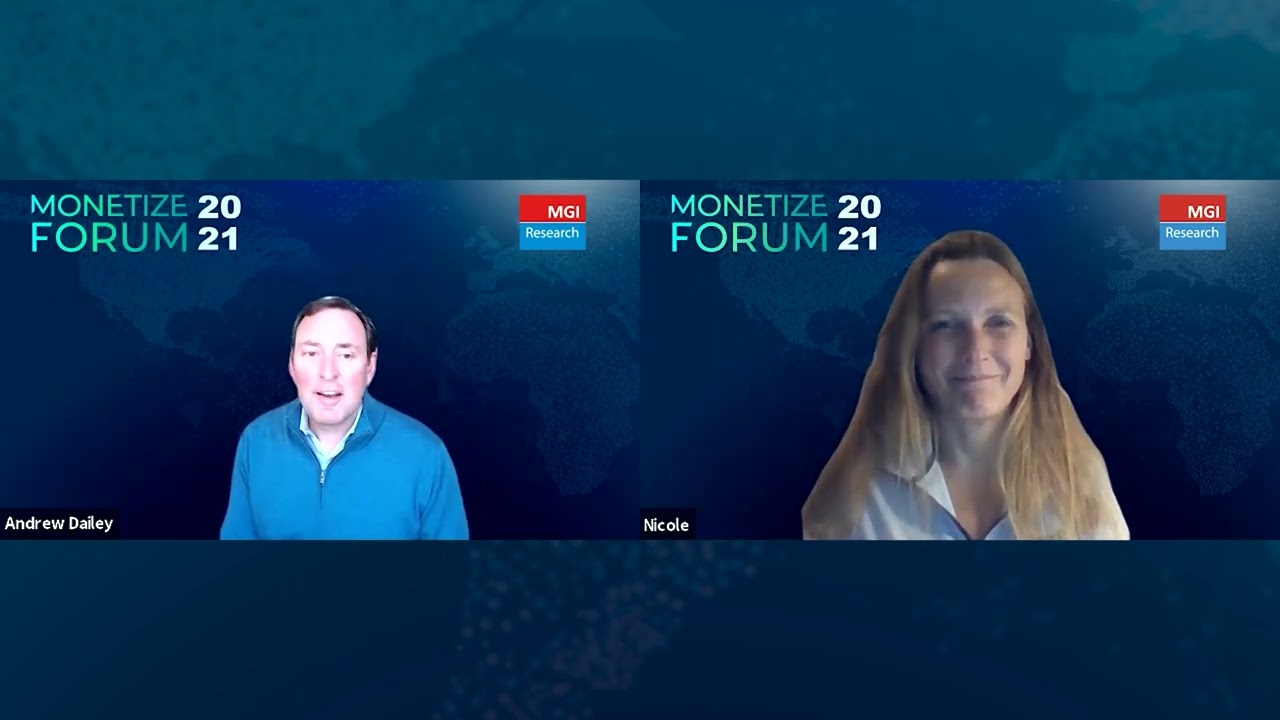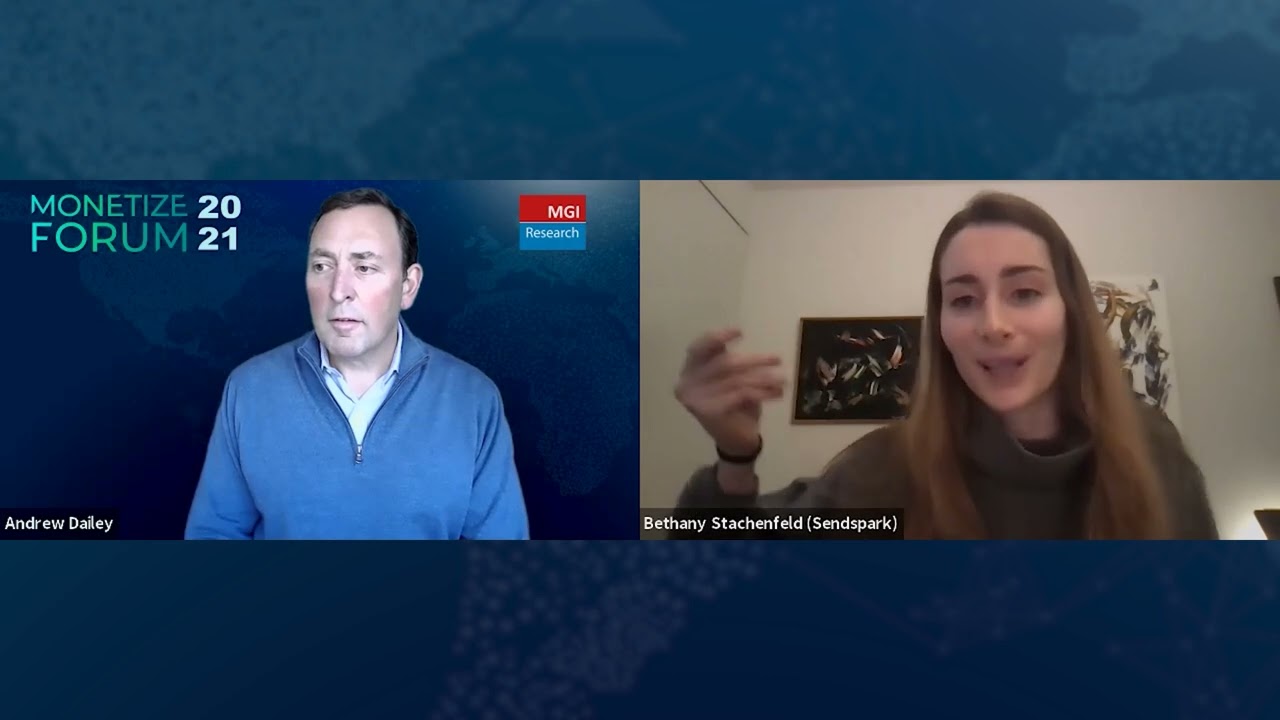
Particularly in the wake of the pandemic, the demand for usage-based, value-led billing is on the rise. Businesses that are innovating for the moment are retaining customers that might otherwise find themselves unable or unwilling to pay for services at this time. B2B SaaS billing solutions leader Chargify has made it their mission to drive growth for their customers by providing truly innovative tools and services. MGI Research analyst Andrew Dailey spoke with Chargify CEO Paul Lynch at the 2021 Monetize Forum to get his insights on which billing solutions providers are stepping up and how both they and their customers are finding success in embracing usage-based billing.
Key Issues
What is value-led pricing, and why is it critical in attracting consumers today?
Who are the winners and losers in the shift from subscription to usage-based billing?
What factors outside of R&D are really driving innovation in this space?
Guest Profile
Paul is a seasoned technology leader with experience across Telco, Hosting, and SaaS. He is currently the CEO of Chargify, the #1 billing solution for B2B SaaS.
Prior to Chargify, Paul guided Assembla Inc. from a struggling product to a successful acquisition, growing the business by over 200% in less than three years.
Andrew Dailey
Welcome to “Driving Product-Led Growth in B2B SaaS.” One way to think about anything as a service business, and especially software as a service business, is that there really are several core levers of the business. One is to drive growth via product innovation. The second is to drive revenues via business model innovation. A third lever is to optimize and improve the bottom line via reduction in churn and with higher renewal rates.
In this session, we’re going to go into those topics in some detail, and I’m sure we’ll delve into some other probably controversial topics as well. I’m delighted to be joined by Paul Lynch, CEO of Chargify. Paul is one of the more passionate voices in billing and monetization today, and we are keen to hear his latest views here on the Monetize Forum stage. Welcome, Paul.
Paul Lynch
Thank you for having me, Andrew.
Andrew Dailey
Let’s jump right into it. We’ve seen a big shift from the arrival of the subscription economy to today’s demand for a much broader set of capabilities, and the hot topic of the moment is the so-called usage economy or the shift towards consumption-based models. You’ve been in this business a long time—what have you seen in terms of the shifting requirements, and where do you see that headed two to three years from now?
Paul Lynch
That’s a great question and a really interesting area, not just for billing and finance, but right across the whole B2B SaaS/B2C SaaS ecosystem. There has been a shift—a quantum shift. At this point, it’s not new; we’ve been seeing it for several years. When Zuora initially came into the market, they came in with a great macro message of powering the subscription economy. The concept is that businesses were no longer prepared to tie up large amounts of CapEx in enterprise software products only to go through a depreciation cycle with hardware vendors. It means buying a big set of IBM SAN and servers or HP SAN and servers to go into an enterprise software company, buying yourself outright for a couple million dollars, then having a maintenance contract on top of that for somewhere between 18% and 24% year-on-year maintenance, and finally three years down the line starting all over again.
The shift towards that fashion of establishing a pipe onto the web, B2B SaaS, and then maintenance going forward happened 10 years ago. We’re now moving away from that kind of subscription-based model where you pay for what you deploy with a set monthly charge into a truly value-led pricing model. And that model is built around usage, consumption, and utility.
So, this is the disruptive force that’s entering our space, by which I mean SaaS. Consumers are more discerning today than they’ve ever been. They’re being hit by more channels in terms of marketing and advertising on a day-to-day basis, and they won’t have the wool pulled over their eyes. They want and demand real value, and if you don’t deliver value to today’s consumers, they aren’t going to maintain business with you for a long period of time. Rather, you’ll be building a sandcastle that’s going to fall down as soon as your customers realize that you’re gouging them. By gouging them, you’re not offering them true value-based pricing.
Andrew Dailey
When you talk about driving product-led growth, what’s involved in that? Is that about spending more on R&D and product development, or is there something else in terms of helping to drive product-led growth?
Paul Lynch
The short answer is yes, it’s way more than just R&D, and it’s way more than just investing in an engineering kind of function within your business. Don’t mistake product-led growth and product-led innovation to drive growth for a closed kind of silo ecosystem as a business where you’re only interested in the product. It’s very different to simply investing all your money in product and slowing up your MVP.
You pinpointed three different areas in terms of levers that can drive growth and success within businesses. This is one of them, and it’s around talking to your customers, talking to the market, and understanding the market instead of innovating or developing products in a bubble. Truly knowing where your customers want you to go means communication, communication, communication. Your customer will tell you what they want; you just need to open your ears and listen. As weird and simplistic as that sounds, so many businesses that we see don’t listen to their customers, they don’t ask for their opinion, and they have this concept that they know better than the customer. As a result, they’ll innovate in areas they feel the customer will require without talking to them.
Andrew Dailey
Let’s talk about the billing and monetization market in particular. We see many of the companies in this space really spend a lot of time marketing their product features and functions. Yet, as you just pointed out, there’s a lot more to finding success, especially in billing. It involves implementation, setting up your product catalog, and maintaining that product catalog. There’s constant change in a monetization environment. It’s adding additional payment methods and rating modalities—among an endless stream of integrations. So, in the context that it’s not just about product, what does it take to make a customer successful through billing? What’s involved? How do you think about overall customer success beyond just what’s in your product?
Paul Lynch
That’s a really, really broad question, Andrew, so let me try to tackle this like I’m eating an elephant—one bite at a time. Firstly, in terms of how you grow and evolve your business and customer base, go back to the most basic idea that it’s not the strongest of the species that survives; it’s the one that’s the most adaptable to change. Businesses in ever-changing and evolving markets need to be adaptable to change, and that change is going to be driven by what their customers demand. Unless you’re a giant powerhouse of a company that completely dominates an industry, you’re going to need to be adaptable to the changing ecosystem in which you’re operating because you can’t dictate that. So that’s the first thing: listening to your customers and asking, “What do they want?” and then adapting to these changing requirements.
A great example of this—not to go to the flavor of the month—is COVID. COVID has created an awful lot of change within the market. Buying cycles have changed, customer perceptions have changed, levels of importance have changed, and access to capital has changed. The businesses that have been succeeding throughout COVID are those that are adapting to the customers’ needs.
So how do you adapt? You adapt by way of product-led innovation. You need to arc or change your product to support what your merchants or customers are requiring from you as a billing and monetization engine. This is about listening to the customer, understanding what they require, and then innovating in those kinds of areas (while not being dictated to by individual customers who may have power in your base). In my opinion, if you do that, everything else follows suit. Where businesses run into difficulty around customer success management and customer support is in not listening to their customers and presuming that they know more about their customers’ business than their customers do.
When I mentioned COVID, I’m talking about the kind of huge event that drives businesses to look inward, look at their processes, and look at their policies. In terms of billing and monetization, for the last 10 years, we’ve been operating in an enormously buoyant economy. We’re seeing B2B SaaS companies, new companies, new startups, and B2C tools. There is a huge growth market around subscriptions, so many companies haven’t felt the requirement or need to innovate. The tide has been going up, so it was enough to just jump into the water—your boat would go up with it. Not anymore. Things are changing, and whenever anything changes and there are shifts, you have winners and losers.
Let’s take a look at the particular area where we focus which is B2B SaaS. In this changing, evolving economy, who’s winning and who’s losing? The winners are the companies that are really engaging in value-based pricing—businesses like Twilio that don’t charge you for access to an SMS gateway but charge you on a granular level down to the very singular sort of unit that you consume. Other examples include SendGrid and Mailgun, businesses that are adopting this whole value pricing methodology and living it as opposed to just talking about it.
The big daddy of all of these companies is Amazon Web Services. They changed the world in 2006 when they launched events-based billing. They called it something different, but it meant basically paying down to the last API call, the last movement of data between S3 and EC2, and the last compute cycle. Where all the traditional hosting companies billed you for what you deployed, Amazon Web Services billed to down to what you used, and that worked.
So, in my view of product-led innovation in our space, this is where the innovation is happening. We’re looking at the market, and we’re seeing clear winners emerging: Twilio, SendGrid, Datadog, Amazon Web Services, E*TRADE…These are businesses that are embracing utility-based billing, billing down to the last event. Because of it, their merchants are seeing that real value, and they’re beginning to pull away from the posse. That’s where you innovate.
Andrew Dailey
In terms of event-based models, it’s one thing just to have the rating capability (to be able to rate events and bill for those). What else is necessary? What else should people be thinking about when they go towards that kind of model?
Paul Lynch
Well, when you get into the rating engines and the multi-attribute-based nature of this, you’re getting very technical and specific into the product. I would take it up a level before I go there and say that what you need to be cognizant of is your customer’s business process of billing models. You need to ensure that what you’re innovating around and solving for is a problem that they actually have.
I don’t think we’re in a position now around utility/usage/events-based billing where we need to inform the customers—I think they know. I think anyone who’s ever used Amazon Web Services, as frustrated as they may have been at the get-go where there wasn’t a real predictability to what their bill would be, still understands entirely that it’s value-led. Yes, you need multi-attribute-based components to your events-based billing. To explain it for those that might not be aware of what that is, it’s not enough that you’re charging per SMS message. You want five attributes in there: SMS message, origination, destination, payload (flat HTML file or a video file that’s going out), time of day…So, really getting into the multi-attributes and showing that from a value perspective is what’s key here—demonstrably showing to your customer (or your merchant if you’re a billing and monetization company) that this is where they can win. We don’t need to inform them anymore as to what this is. People understand usage and batch-based billing. They understand mediation services and aggregators. It’s about showing the real value in how they can be successful in their market with their customers if they adopt this kind of billing methodology.
Andrew Dailey
Let’s talk about Chargify. You’ve made a real investment, a real choice or bet, if you will, on events-based billing. You’ve also rolled out a number of partnerships in other areas across the monetization platform. What do you think about the trade-off between where you’re going to make acquisitions or deep product investments versus the areas where you want to partner? What should we be thinking about or looking for from Chargify over the next couple of years in terms of both more potential acquisitions and partnerships?
Paul Lynch
We’re certainly open to partnerships in every area. As far as where I don’t really want to invest, I feel the payments market has lots of strong players and lots of choices. We integrate specifically with 26 different payment gateways, so I feel that’s something we’ve already covered pretty well as far as our customer base is concerned, though we might do some further small innovations in that area.
As far as functionality at our core and defining what Chargify is and what every CEO and CFO should know about Chargify, we’re your partner if you’re a B2B SaaS company in the area of complex billing and product catalog management—that’s it. We’re not going to be Stripe, just like Stripe isn’t going to be us. They’re an amazing company, and they’re going to drive further, probably into banking. That’s the direction I see this business taking. I don’t want to move in Stripe’s direction and compete against them in terms of PayFacs. I don’t want to get overly hot in different areas that are non-core to billing. I know what we do well. We do very well around complex billing scenarios. That’s where we’ll innovate—where our merchants want us to innovate and offer real value by enabling them to go to each of their customers and say, “Look, it’s value-based pricing. We’re helping you in this area.” Let’s drive that.
I’ve been in the chair here—as you know, Andrew—for about two years. One of the reasons I was so excited about this opportunity when it arose for me was that I felt there’s been an enormous, egregious lack of innovation in this area. Lots of the billing companies have been resting on their laurels. They’ve looked at Zuora, and Zuora’s done nothing. They coined the expression, “the subscription economy,” and then they moved to sales and marketing their product. In my opinion, they haven’t had a product-led, innovation-led growth strategy.
Zuora’s a great company, and I don’t want to come across as being deprecating towards them as they’ve done great things. However, they haven’t been great around innovation. I feel there’s a position in this market for an emergent, strong player that’s well-capitalized with great growth—like Chargify—to really leap away from the market by offering innovative tools, innovative billing services that aren’t in the market at the moment to drive growth for our merchants. That’s where we win.
Andrew Dailey
One last question here: Chargify has kind of taken a Swiss approach in carving out a role that’s independent of Salesforce, Microsoft, and any of the big platforms. Do you think that’s a viable strategy going forward, or, at some point, do you feel like you’ll need to get closer to one of the big platform companies? It could even be Amazon, for example. Nobody’s really innovated on Amazon billing—why not? Where does Chargify see itself in terms of alignment with the major platforms?
Paul Lynch
I think Chargify’s position as the Switzerland here is a very succinct analogy. I don’t think we need to. A journalist asked me last week, “Why didn’t Amazon take this underlying billing technology and release it to the market?” It’s a very good question and one I don’t really have an answer for. The next time I’m having tea with Jeff Bezos I must ask him. Basically, I think it’s difficult. These kinds of billing scenarios and complexities that we’re looking to solve for are hard to do. The likes of Amazon and Salesforce are brilliant because they have great focus in certain areas. Amazon is the best online store, the best logistics back-end engine, and the best infrastructure as a service play. Do they really want to get into billing? I don’t think so. Similarly, Salesforce is great around CRM—they know where they’re winning.
How long will we maintain a neutral type of position in the market? I think the answer is as long as it makes sense. At a certain point, if the opportunity arose for us to get higher or hyper-growth above where we’re currently at, it’s definitely something we’d consider. But it’s not in the plans yet. What we want to do now is build relevant, disruptive products. We want to release those to our merchants. We want our merchants to utilize them. We want to drive adoption. We’re seeing great growth from that strategy. Aligning ourselves to one particular player in the market, right now, really makes no sense to us. Let’s just continue to operate as we’re doing, grow the business, and drive value.
Andrew Dailey
Terrific. Paul, thanks very much for your time today, and thanks everyone for joining us. Paul and the team will be available at the booth today and throughout the Monetize Forum. So, thank you everyone, and enjoy the rest of the Forum.
Paul Lynch
Thanks everyone, and thank you, Andrew. All the best.




